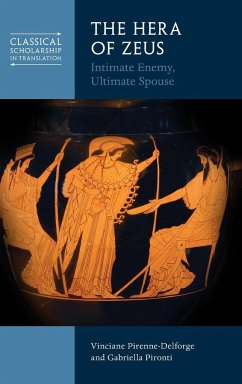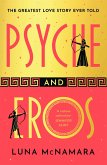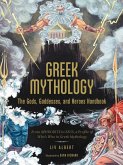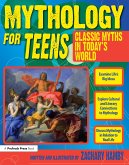- Gebundenes Buch
- Merkliste
- Auf die Merkliste
- Bewerten Bewerten
- Teilen
- Produkt teilen
- Produkterinnerung
- Produkterinnerung
Rethinks the configuration of power and the workings of polytheism in ancient Greece through exploring the tensions inhabiting the figure of the goddess Hera, who was the intimate but hostile wife of Zeus and the queen on Olympus as well as in the cities inhabited by her worshippers.
Andere Kunden interessierten sich auch für
![Hera Hera]() Jennifer SaintHera12,99 €
Jennifer SaintHera12,99 €![Psyche and Eros Psyche and Eros]() Luna McNamaraPsyche and Eros8,99 €
Luna McNamaraPsyche and Eros8,99 €![Hera Hera]() Jennifer SaintHera20,99 €
Jennifer SaintHera20,99 €![Greek Mythology: The Gods, Goddesses, and Heroes Handbook Greek Mythology: The Gods, Goddesses, and Heroes Handbook]() Liv AlbertGreek Mythology: The Gods, Goddesses, and Heroes Handbook11,99 €
Liv AlbertGreek Mythology: The Gods, Goddesses, and Heroes Handbook11,99 €![Mythology for Teens Mythology for Teens]() Zachary HambyMythology for Teens31,99 €
Zachary HambyMythology for Teens31,99 €![The First Fossil Hunters The First Fossil Hunters]() Adrienne MayorThe First Fossil Hunters20,99 €
Adrienne MayorThe First Fossil Hunters20,99 €![Herc Herc]() Phoenicia RogersonHerc26,99 €
Phoenicia RogersonHerc26,99 €-
-
-
Rethinks the configuration of power and the workings of polytheism in ancient Greece through exploring the tensions inhabiting the figure of the goddess Hera, who was the intimate but hostile wife of Zeus and the queen on Olympus as well as in the cities inhabited by her worshippers.
Hinweis: Dieser Artikel kann nur an eine deutsche Lieferadresse ausgeliefert werden.
Hinweis: Dieser Artikel kann nur an eine deutsche Lieferadresse ausgeliefert werden.
Produktdetails
- Produktdetails
- Classical Scholarship in Translation
- Verlag: Cambridge University Press
- Seitenzahl: 404
- Erscheinungstermin: 12. Januar 2022
- Englisch
- Abmessung: 235mm x 157mm x 26mm
- Gewicht: 722g
- ISBN-13: 9781108841030
- ISBN-10: 1108841031
- Artikelnr.: 62289318
- Herstellerkennzeichnung
- Libri GmbH
- Europaallee 1
- 36244 Bad Hersfeld
- gpsr@libri.de
- Classical Scholarship in Translation
- Verlag: Cambridge University Press
- Seitenzahl: 404
- Erscheinungstermin: 12. Januar 2022
- Englisch
- Abmessung: 235mm x 157mm x 26mm
- Gewicht: 722g
- ISBN-13: 9781108841030
- ISBN-10: 1108841031
- Artikelnr.: 62289318
- Herstellerkennzeichnung
- Libri GmbH
- Europaallee 1
- 36244 Bad Hersfeld
- gpsr@libri.de
Vinciane Pirenne-Delforge is a Professor at the Collège de France after having been a researcher at the F.N.R.S. (Belgium) and taught at the Université de Liège. She is also the author of L'Aphrodite grecque (1994), Retour à la source. Pausanias et la religion grecque (2008), and Le Polythéisme grec à l'épreuve d'Hérodote (2020).
Preface by Fritz Graf; Introduction; Chapter I. On Olympus: Conjugal Bed and Royal Throne: 1. A kind of overture: Hera's characteristic epithets; 2. Ultimate spouse; 2.1. 'Sister and wife': family affairs; 2.2. The supreme beauty of the divine spouse; 2.3. Dios apat
and the erotic power of parthenia; 2.4. Marriage and sovereignty; 3. Intimate enemy; 3.1. The sovereign queen, eris and cholos; 3.2. In the midst of the battle: the mother of Ares; 3.3. The play of eris and the place of the queen; 4. Hera, between childbirth and filiation; 4.1. The problematic status of Hephaistos; 4.2. The mother of Eileithyia in action; 4.3. From the labour of Eileithyia to the filiation; 4.4. The jealousy of Hera and the children of Zeus; 5. The lineage and the nurse; 6. The queen's ultimate challenge: on the traces of a lost hymn? 6.1. The text; 6.2. From the wrath of Hera to a cosmic crisis; 6.3. The return of order and constructive eris; 6.4. From the intimate enemy to the ultimate spouse; 7. The Hera of Zeus in archaic poetry; Chapter 2. In the cities: Teleia and Basileia; 1. As a prelude: exclusive cult-titles; 2. Stymphalus and the Hera-cycle; 3. The Daidala of Plataia; 3.1. The goddess of Kithairon; 3.2. The narratives and the cycle; 3.3 The procession and the sacrifice; 3.4 Marriage, sovereignty, reconciliation; 4. The Goddess of Argos in her dwelling; 4.1. The Goddess of Argos, the Argive plain, and the city of Argos; 4.2. The traces of the cycle about the goddess between myths and rites; 4.3. Veils of marriage and a veiled marriage; 4.4. The sceptre, the cuckoo, the throne; 4.5. Hera and the sovereignty of Zeus; 5. The sovereign bride of Samos; 5.1. A grandiose temple in the middle of the Aegean; 5.2. In the shadow of the chastetree: birth, parthenia, separation, and return; 5.3. 'The glorious young bride of Zeus, queen of the island'; 5.4. Mistress of the island, offerings and donors; 6. From Olympus to Olympia; 6.1. Heaven on earth; 6.2 The archaic temple at the heart of the Altis; 6.3. Hera at the centre of the Olympian pantheon: the monuments; 6.4. Hera in the heart of the Olympian pantheon: taking control of the theogony; 6.5. The power of sovereignty: Olympios/Olympia; 6.6. The conjugal bed and the throne: Pelops and Hippodamia; 6.7. Competition, "synecism" and marriage: the H
raia; 6.8. Return to the Heraion; 7. The Hera of Zeus and the Zeus of Hera; 7.1 Powers of accomplishment: Teleios-Teleia; 7.2. At Athens a hieros gamos and some sacrificial precautions; 8. The sovereign Queen: cult-title, ritual and topography; 8.1. When she is the 'Queen'; 8.2. Ascending toward the Kynthos at Delos; 8.3. The Basileia of Lesbos: new information from Sappho; 8.4. Hera at Perachora and the Bounaia of Corinth; 8.5. The sovereign queen of the Achaeans in the West; 9. From the city-cults to Olympus: return to Dios apat
; Chapter 3. From anger to glory: testing and legitimising: 1. Cholos: profiling an angry goddess; 2. Gaining access to Olympus; 3. Herakles, Hera and kleos; 3.1. The glory of Hera, glory by way of Hera; 3.2. 'Now she loves him...'; 3.3. Monster and trials; 3.4. Legitimation, wet-nursing, and marriage; 3.5. Hebe, daughter of Hera, and the h
b
; 4. Dionysus, 'the god who arrives...' on Olympus; 4.1. From the anger of the wife to the immortality of the son; 4.2. The throne of the queen: integration and re-integration; 4.3. Constructive antagonisms; 5. The fabrication of Olympus in images; 5.1. 'As if she were her daughter, too...'; 5.2. The wife of Zeus vis-à-vis Dionysus; 6. Heroic stakes and the crises of sovereignty; 6.1. From Laius to Oedipus; 6.2. From Pelias to Jason; 6.2.1. The kleos of the Argonauts; 6.2.2. The hybris of Pelias; Envoi.
and the erotic power of parthenia; 2.4. Marriage and sovereignty; 3. Intimate enemy; 3.1. The sovereign queen, eris and cholos; 3.2. In the midst of the battle: the mother of Ares; 3.3. The play of eris and the place of the queen; 4. Hera, between childbirth and filiation; 4.1. The problematic status of Hephaistos; 4.2. The mother of Eileithyia in action; 4.3. From the labour of Eileithyia to the filiation; 4.4. The jealousy of Hera and the children of Zeus; 5. The lineage and the nurse; 6. The queen's ultimate challenge: on the traces of a lost hymn? 6.1. The text; 6.2. From the wrath of Hera to a cosmic crisis; 6.3. The return of order and constructive eris; 6.4. From the intimate enemy to the ultimate spouse; 7. The Hera of Zeus in archaic poetry; Chapter 2. In the cities: Teleia and Basileia; 1. As a prelude: exclusive cult-titles; 2. Stymphalus and the Hera-cycle; 3. The Daidala of Plataia; 3.1. The goddess of Kithairon; 3.2. The narratives and the cycle; 3.3 The procession and the sacrifice; 3.4 Marriage, sovereignty, reconciliation; 4. The Goddess of Argos in her dwelling; 4.1. The Goddess of Argos, the Argive plain, and the city of Argos; 4.2. The traces of the cycle about the goddess between myths and rites; 4.3. Veils of marriage and a veiled marriage; 4.4. The sceptre, the cuckoo, the throne; 4.5. Hera and the sovereignty of Zeus; 5. The sovereign bride of Samos; 5.1. A grandiose temple in the middle of the Aegean; 5.2. In the shadow of the chastetree: birth, parthenia, separation, and return; 5.3. 'The glorious young bride of Zeus, queen of the island'; 5.4. Mistress of the island, offerings and donors; 6. From Olympus to Olympia; 6.1. Heaven on earth; 6.2 The archaic temple at the heart of the Altis; 6.3. Hera at the centre of the Olympian pantheon: the monuments; 6.4. Hera in the heart of the Olympian pantheon: taking control of the theogony; 6.5. The power of sovereignty: Olympios/Olympia; 6.6. The conjugal bed and the throne: Pelops and Hippodamia; 6.7. Competition, "synecism" and marriage: the H
raia; 6.8. Return to the Heraion; 7. The Hera of Zeus and the Zeus of Hera; 7.1 Powers of accomplishment: Teleios-Teleia; 7.2. At Athens a hieros gamos and some sacrificial precautions; 8. The sovereign Queen: cult-title, ritual and topography; 8.1. When she is the 'Queen'; 8.2. Ascending toward the Kynthos at Delos; 8.3. The Basileia of Lesbos: new information from Sappho; 8.4. Hera at Perachora and the Bounaia of Corinth; 8.5. The sovereign queen of the Achaeans in the West; 9. From the city-cults to Olympus: return to Dios apat
; Chapter 3. From anger to glory: testing and legitimising: 1. Cholos: profiling an angry goddess; 2. Gaining access to Olympus; 3. Herakles, Hera and kleos; 3.1. The glory of Hera, glory by way of Hera; 3.2. 'Now she loves him...'; 3.3. Monster and trials; 3.4. Legitimation, wet-nursing, and marriage; 3.5. Hebe, daughter of Hera, and the h
b
; 4. Dionysus, 'the god who arrives...' on Olympus; 4.1. From the anger of the wife to the immortality of the son; 4.2. The throne of the queen: integration and re-integration; 4.3. Constructive antagonisms; 5. The fabrication of Olympus in images; 5.1. 'As if she were her daughter, too...'; 5.2. The wife of Zeus vis-à-vis Dionysus; 6. Heroic stakes and the crises of sovereignty; 6.1. From Laius to Oedipus; 6.2. From Pelias to Jason; 6.2.1. The kleos of the Argonauts; 6.2.2. The hybris of Pelias; Envoi.
Preface by Fritz Graf; Introduction; Chapter I. On Olympus: Conjugal Bed and Royal Throne: 1. A kind of overture: Hera's characteristic epithets; 2. Ultimate spouse; 2.1. 'Sister and wife': family affairs; 2.2. The supreme beauty of the divine spouse; 2.3. Dios apat
and the erotic power of parthenia; 2.4. Marriage and sovereignty; 3. Intimate enemy; 3.1. The sovereign queen, eris and cholos; 3.2. In the midst of the battle: the mother of Ares; 3.3. The play of eris and the place of the queen; 4. Hera, between childbirth and filiation; 4.1. The problematic status of Hephaistos; 4.2. The mother of Eileithyia in action; 4.3. From the labour of Eileithyia to the filiation; 4.4. The jealousy of Hera and the children of Zeus; 5. The lineage and the nurse; 6. The queen's ultimate challenge: on the traces of a lost hymn? 6.1. The text; 6.2. From the wrath of Hera to a cosmic crisis; 6.3. The return of order and constructive eris; 6.4. From the intimate enemy to the ultimate spouse; 7. The Hera of Zeus in archaic poetry; Chapter 2. In the cities: Teleia and Basileia; 1. As a prelude: exclusive cult-titles; 2. Stymphalus and the Hera-cycle; 3. The Daidala of Plataia; 3.1. The goddess of Kithairon; 3.2. The narratives and the cycle; 3.3 The procession and the sacrifice; 3.4 Marriage, sovereignty, reconciliation; 4. The Goddess of Argos in her dwelling; 4.1. The Goddess of Argos, the Argive plain, and the city of Argos; 4.2. The traces of the cycle about the goddess between myths and rites; 4.3. Veils of marriage and a veiled marriage; 4.4. The sceptre, the cuckoo, the throne; 4.5. Hera and the sovereignty of Zeus; 5. The sovereign bride of Samos; 5.1. A grandiose temple in the middle of the Aegean; 5.2. In the shadow of the chastetree: birth, parthenia, separation, and return; 5.3. 'The glorious young bride of Zeus, queen of the island'; 5.4. Mistress of the island, offerings and donors; 6. From Olympus to Olympia; 6.1. Heaven on earth; 6.2 The archaic temple at the heart of the Altis; 6.3. Hera at the centre of the Olympian pantheon: the monuments; 6.4. Hera in the heart of the Olympian pantheon: taking control of the theogony; 6.5. The power of sovereignty: Olympios/Olympia; 6.6. The conjugal bed and the throne: Pelops and Hippodamia; 6.7. Competition, "synecism" and marriage: the H
raia; 6.8. Return to the Heraion; 7. The Hera of Zeus and the Zeus of Hera; 7.1 Powers of accomplishment: Teleios-Teleia; 7.2. At Athens a hieros gamos and some sacrificial precautions; 8. The sovereign Queen: cult-title, ritual and topography; 8.1. When she is the 'Queen'; 8.2. Ascending toward the Kynthos at Delos; 8.3. The Basileia of Lesbos: new information from Sappho; 8.4. Hera at Perachora and the Bounaia of Corinth; 8.5. The sovereign queen of the Achaeans in the West; 9. From the city-cults to Olympus: return to Dios apat
; Chapter 3. From anger to glory: testing and legitimising: 1. Cholos: profiling an angry goddess; 2. Gaining access to Olympus; 3. Herakles, Hera and kleos; 3.1. The glory of Hera, glory by way of Hera; 3.2. 'Now she loves him...'; 3.3. Monster and trials; 3.4. Legitimation, wet-nursing, and marriage; 3.5. Hebe, daughter of Hera, and the h
b
; 4. Dionysus, 'the god who arrives...' on Olympus; 4.1. From the anger of the wife to the immortality of the son; 4.2. The throne of the queen: integration and re-integration; 4.3. Constructive antagonisms; 5. The fabrication of Olympus in images; 5.1. 'As if she were her daughter, too...'; 5.2. The wife of Zeus vis-à-vis Dionysus; 6. Heroic stakes and the crises of sovereignty; 6.1. From Laius to Oedipus; 6.2. From Pelias to Jason; 6.2.1. The kleos of the Argonauts; 6.2.2. The hybris of Pelias; Envoi.
and the erotic power of parthenia; 2.4. Marriage and sovereignty; 3. Intimate enemy; 3.1. The sovereign queen, eris and cholos; 3.2. In the midst of the battle: the mother of Ares; 3.3. The play of eris and the place of the queen; 4. Hera, between childbirth and filiation; 4.1. The problematic status of Hephaistos; 4.2. The mother of Eileithyia in action; 4.3. From the labour of Eileithyia to the filiation; 4.4. The jealousy of Hera and the children of Zeus; 5. The lineage and the nurse; 6. The queen's ultimate challenge: on the traces of a lost hymn? 6.1. The text; 6.2. From the wrath of Hera to a cosmic crisis; 6.3. The return of order and constructive eris; 6.4. From the intimate enemy to the ultimate spouse; 7. The Hera of Zeus in archaic poetry; Chapter 2. In the cities: Teleia and Basileia; 1. As a prelude: exclusive cult-titles; 2. Stymphalus and the Hera-cycle; 3. The Daidala of Plataia; 3.1. The goddess of Kithairon; 3.2. The narratives and the cycle; 3.3 The procession and the sacrifice; 3.4 Marriage, sovereignty, reconciliation; 4. The Goddess of Argos in her dwelling; 4.1. The Goddess of Argos, the Argive plain, and the city of Argos; 4.2. The traces of the cycle about the goddess between myths and rites; 4.3. Veils of marriage and a veiled marriage; 4.4. The sceptre, the cuckoo, the throne; 4.5. Hera and the sovereignty of Zeus; 5. The sovereign bride of Samos; 5.1. A grandiose temple in the middle of the Aegean; 5.2. In the shadow of the chastetree: birth, parthenia, separation, and return; 5.3. 'The glorious young bride of Zeus, queen of the island'; 5.4. Mistress of the island, offerings and donors; 6. From Olympus to Olympia; 6.1. Heaven on earth; 6.2 The archaic temple at the heart of the Altis; 6.3. Hera at the centre of the Olympian pantheon: the monuments; 6.4. Hera in the heart of the Olympian pantheon: taking control of the theogony; 6.5. The power of sovereignty: Olympios/Olympia; 6.6. The conjugal bed and the throne: Pelops and Hippodamia; 6.7. Competition, "synecism" and marriage: the H
raia; 6.8. Return to the Heraion; 7. The Hera of Zeus and the Zeus of Hera; 7.1 Powers of accomplishment: Teleios-Teleia; 7.2. At Athens a hieros gamos and some sacrificial precautions; 8. The sovereign Queen: cult-title, ritual and topography; 8.1. When she is the 'Queen'; 8.2. Ascending toward the Kynthos at Delos; 8.3. The Basileia of Lesbos: new information from Sappho; 8.4. Hera at Perachora and the Bounaia of Corinth; 8.5. The sovereign queen of the Achaeans in the West; 9. From the city-cults to Olympus: return to Dios apat
; Chapter 3. From anger to glory: testing and legitimising: 1. Cholos: profiling an angry goddess; 2. Gaining access to Olympus; 3. Herakles, Hera and kleos; 3.1. The glory of Hera, glory by way of Hera; 3.2. 'Now she loves him...'; 3.3. Monster and trials; 3.4. Legitimation, wet-nursing, and marriage; 3.5. Hebe, daughter of Hera, and the h
b
; 4. Dionysus, 'the god who arrives...' on Olympus; 4.1. From the anger of the wife to the immortality of the son; 4.2. The throne of the queen: integration and re-integration; 4.3. Constructive antagonisms; 5. The fabrication of Olympus in images; 5.1. 'As if she were her daughter, too...'; 5.2. The wife of Zeus vis-à-vis Dionysus; 6. Heroic stakes and the crises of sovereignty; 6.1. From Laius to Oedipus; 6.2. From Pelias to Jason; 6.2.1. The kleos of the Argonauts; 6.2.2. The hybris of Pelias; Envoi.








